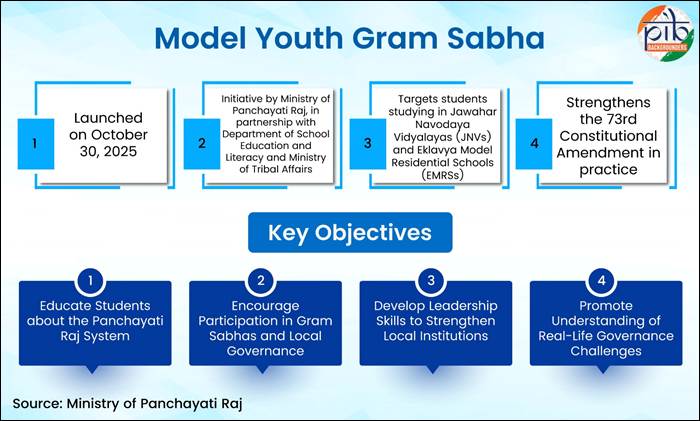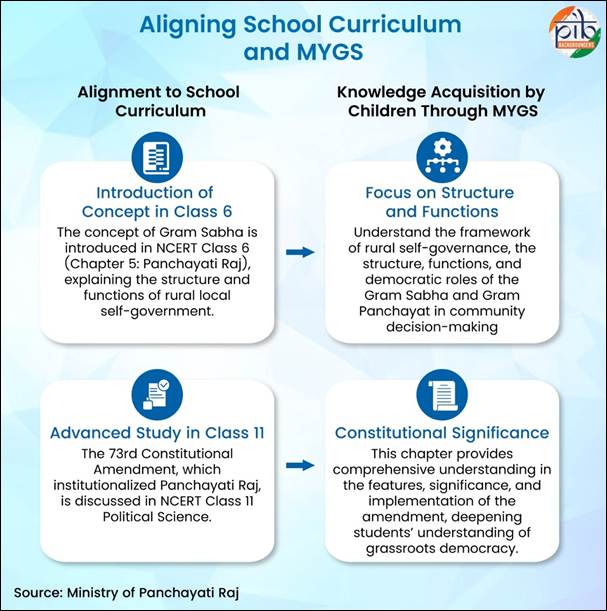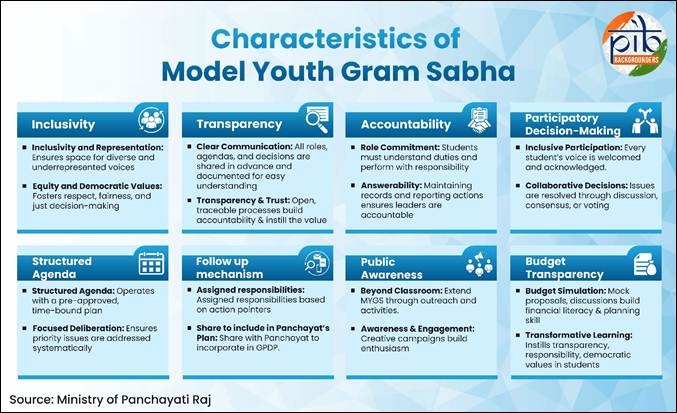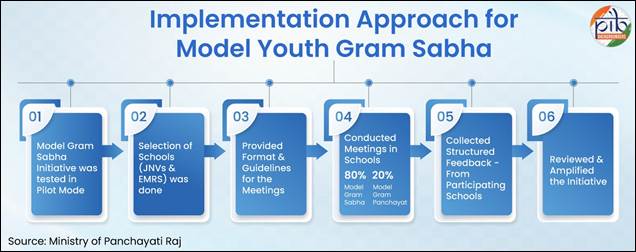Rural Prosperity
Model Youth Gram Sabha
“Loktantra Ki Pathshala”
Posted On:
30 OCT 2025 3:41PM
Key Takeaways
- The Model Youth Gram Sabha (MYGS) equips students with hands-on experience in grassroots democracy, simulating real gram sabha processes to build leadership and civic engagement.
- It strengthens youth understanding of the Panchayati Raj System and promotes transparency, inclusion, and accountability in local governance.
- The initiative aligns closely with the National Education Policy (NEP) 2020 by nurturing constitutional values, social responsibility, and civic consciousness among students, preparing them for active citizenship.
- Structured facilitation through trained educators and standardized modules ensures high-quality implementation and measurable learning outcomes.
- The programme fosters youth participation in governance while developing essential life skills such as communication, critical thinking, teamwork, and consensus-building and decision-making for democratic engagement.
Introduction
India’s villages form the very foundation of its democracy, representing heritage, economy, and collective aspiration. With over 6.64 lakh villages housing nearly 65-70% of the population, the vitality of rural India lies in the strength of its Gram Sabhas. As a constitutional body under Article 243, the Gram Sabha embodies direct democracy, enabling every adult resident of the village to participate in governance, deliberate on development priorities, and ensure accountability of Panchayati Raj Institutions (PRIs). It reflects the true spirit of governance “of the people, by the people, and for the people,” fostering transparency, inclusivity, and participatory planning at the grassroots level.
Despite its critical role in rural governance, youth participation in Gram Sabhas remains low, largely due to limited awareness, insufficient exposure, and a lack of meaningful engagement opportunities. India has the world’s largest youth population, and meaningful and productive involvement of our youth in community development and local governance is the key to India achieving its vision of Viksit Bharat. Their participation will strengthen the foundation of grassroots democracy and build better opportunities for inclusive and representative decision-making.
To encourage and cultivate civic consciousness among students, the Ministry of Panchayati Raj, in partnership with the Department of School Education and Literacy and the Ministry of Tribal Affairs, has conceptualised the “Model Youth Gram Sabha” (MYGS), an innovative civic education initiative aimed at nurturing democratic values and public responsibility among young citizens.
Modelled on the format of simulated assemblies, the MYGS provides students, particularly from Jawahar Navodaya Vidyalayas (JNVs) and Eklavya Model Residential Schools (EMRSs), with hands-on exposure to the functioning of grassroots democracy. Through role-play, debates, and decision-making exercises, students experience the processes of deliberation, consensus-building, and participatory governance. This experiential learning not only enhances their understanding of local self-governance but also instils a sense of accountability, cooperation, and respect for democratic institutions.
What are JNVs and EMRSs?
Jawahar Navodaya Vidyalayas (JNVs) are the residential schools established under the National Policy on Education (1986) that aim to bring out the best of rural talent. They are established to provide quality modern education, including cultural, environmental, and physical development, to talented rural children irrespective of their socio-economic background.
Eklavya Model Residential Schools (EMRSs) have been set up to provide quality upper primary, secondary, and senior secondary level education to Scheduled Tribes (ST) students in remote areas to enable them to access the best opportunities in education and to bring them at par with the general population.
The 73rd Constitutional Amendment laid the groundwork for a three-tier Panchayati Raj system, empowering governance at the village, block, and district levels. By encouraging young minds to understand and engage with this framework, especially through initiatives like the Model Youth Gram Sabha, the Ministry envisions creating an informed and empowered generation that values democratic participation, constitutional ideals, and collective progress.

The Model Youth Gram Sabha initiative is strongly aligned closely with the vision of the National Education Policy (NEP) 2020, which underscores the need for educational curriculum and pedagogy to instill in students a deep respect for the Fundamental Duties and Constitutional values, along with a strong sense of national belonging. NEP 2020 emphasizes preparing learners to understand their roles and responsibilities in a rapidly changing world. The Policy envisions fostering in young people a profound pride in being Indian, reflected in their thoughts, actions, and intellect, while equipping them with the knowledge, skills, values, and attitudes that promote human rights, sustainable development, and global well-being, ultimately shaping them into responsible and compassionate global citizens.

Objectives
The Model Youth Gram Sabha familiarizes students with the structure and functioning of Panchayati Raj Institutions through participatory and experiential learning. It develops civic and leadership skills such as public speaking, critical thinking, and consensus-building while promoting values of inclusion, accountability, and transparency. By engaging youth in deliberating real community issues, the initiative nurtures informed and responsible citizens who actively contribute to democratic and developmental processes. Its key objectives are to:
Educate Students about the Panchayati Raj System – Introduce students to the three-tier Panchayati Raj framework established through the 73rd Constitutional Amendment.
Encourage Participation – Motivate students to engage in Gram Sabhas and local governance processes.
Develop Leadership Skills – Foster a sense of responsibility and leadership among youth towards strengthening Panchayati Raj Institutions (PRIs).
Promote Understanding of Local Issues – Provide a platform for students to discuss and analyze real-life governance challenges at the grassroots level
Vision
The vision of the Model Youth Gram Sabha is “to nurture empowered, responsible, and empathetic young citizens who actively participate in democratic processes and contribute to sustainable and inclusive national development.”
The core vision of MYGS is aimed to:
- Foster active, empathetic, and informed citizenship among youth, rooted in constitutional values and democratic principles.
- Instil values of inclusivity, consensus building, justice, and equity. Empower students to become socially responsible individuals.
- Build important life skills such as leadership, participation, communication, critical thinking etc. among students.
- Strengthen awareness on local governance structures and Localized Sustainable Development Goals.
- Empower students to become socially responsible individuals committed to national integration and development.
Characteristics of a Model Youth Gram Sabha

Conducting a Model Gram Sabha/Gram Panchayat Meeting
In the Model Gram Sabha activity, students take on various roles to simulate real-world local governance.
Some students may be designated as post holders, such as Sarpanch, Ward Members, or Presidents, while others may represent Standing Committees, Panchayat functionaries (like Secretary, PDO, or Sahayak), frontline workers (such as ASHA, AWW, or Rojgar Sahayak), or officers from line departments, including Rural Development, Health, and WCD. Groups of students also represent different social segments of the Gram Panchayat to voice their community-specific concerns.
The meeting process includes advance preparation, like circulating the agenda, issuing meeting notices at least ten days before the scheduled meeting, and disseminating meeting details widely. During the meeting, the Sarpanch leads with introductions, followed by presentations on past decisions, work-in-progress, new agendas, and finalization of the action plan. In addition, they facilitate discussions on financial management, including budget finalization, assessment of available funds, estimation of proposed works, and identification of funding gaps. They also explore potential sources for mobilizing additional financial resources. Students actively deliberate on addressing these gaps by proposing innovative ideas for local revenue generation.
Decision-making involves voting on key proposals, after which the Sarpanch summarizes the resolutions. The session concludes with the Minute Recorder drafting formal resolutions and the Sarpanch closing the meeting.
Implementation Approach
A pilot Model Gram Sabha/Gram Panchayat was conducted in selected JNVs and EMRSs in March-April 2025. A format was provided, covering end to end process of conducting these meetings, along with the structure of Model Gram Sabha/Gram Panchayat. The above structure was also made available in the form of a short video for better understanding.

Model Gram Panchayat meetings were organised in 20% of the schools and Model Gram Sabha meetings were organised in 80% of the schools. Once these meetings were successfully conducted, structured feedback was collected for assessment from participating schools, based on which required revision to the Standard Operating Protocol (SOP), and amplification was carried out to further scale up the initiative.
The initiative is progressing in a structured manner as outlined in the timeline.
- In July 2025, various schools were identified. This was followed by an orientation programme for 200 master trainers and teachers conducted during July–August 2025 to equip them for the upcoming activities.
- Subsequently, Mock Gram Sabha sessions were organized in the identified schools, like at Baghpat (Uttar Pradesh) and Alwar (Rajasthan) during August–September 2025, providing students with practical exposure to local governance processes.
- Furthermore, regional competitions are being held across five regions in October–November 2025, leading to the selection of ten finalist teams (five from JNVs and five from EMRSs).
- The initiative will culminate in a National Competition in December 2025, where the top three teams among the ten finalists will be felicitated for their outstanding performance.
Model Youth Gram Sabha Module
The Model Youth Gram Sabha Module serves as a comprehensive framework designed to translate the vision of participatory democracy into practice within schools. It ensures effective, engaging, and high-quality implementation of youth-led Gram Sabhas by equipping educators and students with structured guidance, facilitation tools, and evaluation mechanisms.
At its core, the MYGS Module is guided by the MLJP framework: Meaning, Learning, Joy, and Pride, which anchors all activities in purposeful engagement, experiential education, and civic empowerment.
The module is divided into three interconnected components:

1. National Level Master Trainer (NLMT) Guide
The National Level Master Trainer (NLMT) Guide for MYGS provides a comprehensive overview of Gram Sabha processes and clearly outlines the roles and responsibilities of facilitators. It incorporates MLJP (Meaning, Learning, Joy, and Pride) principles and includes step-by-step tools to support effective and engaging facilitation.
2. Facilitation of Training Module for Teachers
The Facilitation Module for Teachers is a simplified, pictorial, and user-friendly resource designed to make learning engaging and participatory. It helps teachers introduce students to the fundamentals of democracy, leadership, and life skills, while guiding them on how to effectively participate in MYGS. The module also provides preparation plans to ensure the smooth execution of the event.
3. Evaluation Framework
The Evaluation Framework is a user-friendly tool designed to assess the effectiveness of MYGS through indicators measured pre, during, and post-event. It also includes differential indicators to identify and recognize schools that demonstrate exemplary performance.
Together, these modules create a holistic ecosystem for school-based civic education, turning classrooms into microcosms of democratic practice. They empower students to experience governance firsthand, build leadership and communication skills, and cultivate a lifelong respect for transparency, inclusion, and accountability, the core values of India’s democratic fabric.
Funding and Recognition of Participating Students and Schools
An amount of Rs. 20,000 per school will be provided to each participating school as a one-time financial assistance for conducting each mock Gram Sabha. The fund may be utilized in the arrangement of a Sabha, including logistic support and refreshment.
- Participating students will be provided certificates of appreciation from the Ministry of Panchayati Raj, motivating them to take an active interest in democratic governance. Best-performing schools will be recognized at the national level, encouraging wider participation.
- There is a token cash award for the winning team at the regional level. The fund may be used for school development.
- Huge cash prizes will be offered to the 3 winning teams at the central level. The fund may be used for school development.
- The ministry would also support the logistics for teams selected for the national-level competition.
Expected Outcomes
The following outcomes are envisaged from the initiative, aimed at nurturing democratic values and youth participation in local governance:
Promoting Participation – To encourage students to actively engage in local governance and understand democratic processes at the grassroots level.
Fostering Young Leadership – To inspire youth to take up leadership roles in local bodies and contribute meaningfully to their communities.
Empowering Youth Voices – To provide a platform for students to express their views on local issues, promoting informed discussions and solutions.
Encouragement for young individuals to actively participate in decision-making processes within their Gram Panchayats.
Conclusion
The Model Gram Sabha will play a vital role in shaping the vision and responsibilities of young minds toward participatory governance. By fostering awareness, leadership, and engagement, this initiative aims to bridge the gap between youth and local governance, ensuring that the next generation is well-equipped to contribute to India’s democratic and developmental journey.
References
Ministry of Panchayati Raj
Ministry of Education
https://dsel.education.gov.in/nvs
Ministry of Tribal Affairs
https://sansad.in/getFile/annex/259/AU2536.pdf?source=pqars
Click here to see pdf
****
SK | SM
(Backgrounder ID: 155820)
Visitor Counter : 265
Provide suggestions / comments